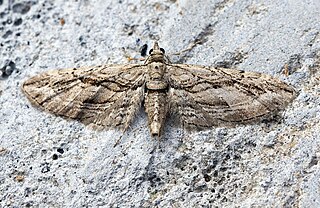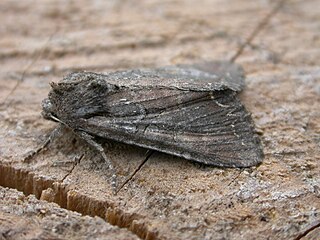
The slender pug is a moth of the family Geometridae. It was first described by Jacob Hübner in 1813 and is found throughout Europe and western parts of the Palearctic. The larva feeds on the catkins of willow.

The mottled pug is a moth of the family Geometridae. The species was first described by Jacob Hübner in 1813. It is found across the Palearctic region apart from around the Mediterranean Sea. It is common in the British Isles apart from Scotland where it is rather local.

The juniper pug or juniper looper is a moth of the family Geometridae. The species was first described by Michael Denis and Ignaz Schiffermüller in 1775. It is found throughout the Palearctic and in the Nearctic.

Apamea crenata, known as the clouded-bordered brindle, is a moth in the family Noctuidae. It is distributed throughout the Palearctic realm. In the North it crosses the Arctic Circle, in the Mediterranean it is found only in cool locations and mountains avoiding very hot areas. In the Alps, it rises to an altitude of about 2000 metres.

Eupithecia innotata, the angle-barred pug, is a moth of the family Geometridae. The species was first described by Johann Siegfried Hufnagel in 1767. It ranges from Spain in the west to western Siberia and Central Asia in the east.

The cloaked pug is a moth of the family Geometridae. The species was first described by Johann August Ephraim Goeze in 1781 and it can be found in Europe and to the east in Siberia and Japan.

Eupithecia phoeniceata, the cypress pug, is a moth of the family Geometridae. The species was first described by Jules Pierre Rambur in 1834 and it can be found in Europe.

Lacanobia suasa, the dog’s tooth, is a moth of the family Noctuidae. It is found in the Palearctic realm.

Eupithecia simpliciata, the plain pug, is a moth of the family Geometridae. It is found in the Palearctic realm, from western Europe to north-western China (Xinjiang). The species primarily colonizes wastelands, rubble and abandoned vineyards, and in Asia also salt steppes. In the Alps, the range of altitude extends up to 1200 metres.

Eupithecia venosata, the netted pug, is a moth of the family Geometridae, first described by the Danish zoologist Johan Christian Fabricius in 1787. It is found across the Palearctic realm from Portugal and Morocco in the west to the Lake Baikal in Siberia and Afghanistan and Pakistan in the east.

Eupithecia niveifascia is a moth in the family Geometridae first described by George Duryea Hulst in 1898. It is found in North America from south-western Alberta west to Vancouver Island, north to northern coastal British Columbia and south to New Mexico.
Eupithecia indissolubilis is a moth in the family Geometridae. It is found in the Shaanxi province of China, and in parts of Russia. It has been found at altitudes between 1100 and 1700 meters. Adults are on wing from early June to early July.
Eupithecia lasciva is a moth in the family Geometridae. It is found in China, where it is known from Tibet, Qinghai, Gansu, Shanxi, Shaanxi, Sichuan, and Yunnan. In Yunnan, specimens have been collected at altitudes up to ca. 4500 meters. Adults are on wing in April, and again from mid-June to mid-September.
Eupithecia latitans is a moth in the family Geometridae. It is found in Peru.
Eupithecia melanograpta is a moth in the family Geometridae. It is found in Peru.
Eupithecia ochrosoma is a moth in the family Geometridae. It is found in Peru.
Eupithecia venulata is a moth in the family Geometridae. It is found in Peru.
Eupithecia versiplaga is a moth in the family Geometridae. It is found in Peru.
Eupithecia yangana is a moth in the family Geometridae. It is found in Ecuador and Peru.
Eupithecia dearmata is a moth in the family Geometridae. It is found in Turkey. Adults have dull grey wings with a large number of scattered dark scales and a wing span of 14–15 mm.










